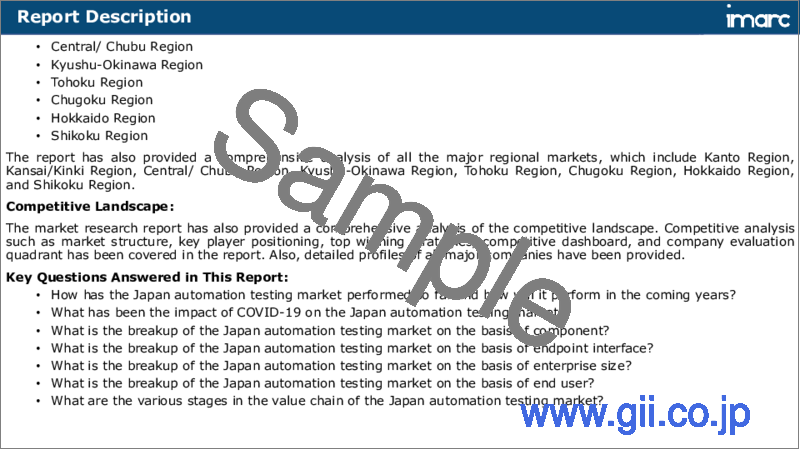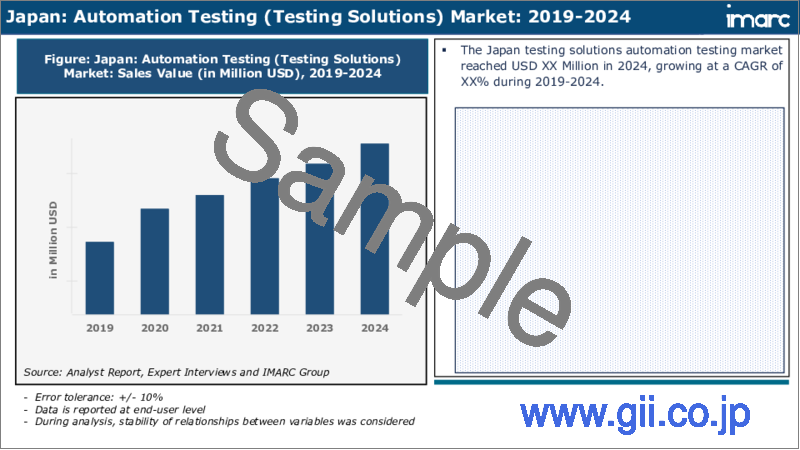|
|
市場調査レポート
商品コード
1609761
日本の自動化テスト市場レポート:コンポーネント、エンドポイントインターフェース、企業規模、エンドユーザー、地域別、2025年~2033年Japan Automation Testing Market Report by Component, Endpoint Interface, Enterprise Size, End User, and Region 2025-2033 |
||||||
カスタマイズ可能
|
|||||||
| 日本の自動化テスト市場レポート:コンポーネント、エンドポイントインターフェース、企業規模、エンドユーザー、地域別、2025年~2033年 |
|
出版日: 2024年12月05日
発行: IMARC
ページ情報: 英文 116 Pages
納期: 5~7営業日
|
全表示
- 概要
- 目次
日本の自動化テスト市場の市場規模は2024年に15億米ドルに達しました。今後、IMARC Groupは、市場は2033年までに46億米ドルに達し、2025年から2033年にかけて13.6%の成長率(CAGR)を示すと予測しています。開発サイクルの初期段階でバグや問題を特定し、ソフトウェア製品の全体的な品質と信頼性を確保できる自動化テストの需要が高まっていることが、市場を牽引しています。
本レポートで扱う主な質問
- 日本の自動化テスト市場のこれまでの実績と、今後の実績は?
- COVID-19が日本の自動化テスト市場に与えた影響は?
- 日本の自動化テスト市場のコンポーネント別の内訳は?
- 日本の自動化テスト市場のエンドポイントインターフェース別の内訳は?
- 日本の自動化テスト市場の企業規模別の内訳は?
- 日本の自動化テスト市場のエンドユーザー別の内訳は?
- 日本の自動化テスト市場のバリューチェーンにはどのような段階がありますか?
- 日本の自動化テストの主な促進要因と課題は?
- 日本の自動化テスト市場の構造と主要プレーヤーは?
- 日本の自動化テスト市場における競合の程度は?
目次
第1章 序文
第2章 調査範囲と調査手法
- 調査の目的
- ステークホルダー
- データソース
- 市場推定
- 調査手法
第3章 エグゼクティブサマリー
第4章 日本の自動化テスト市場:イントロダクション
- 概要
- 市場力学
- 業界動向
- 競合情報
第5章 日本の自動化テスト市場情勢
- 過去および現在の市場動向(2019年~2024年)
- 市場予測(2025-2033)
第6章 日本の自動化テスト市場:コンポーネント別の内訳
- テストソリューション
- サービス
第7章 日本の自動化テスト市場:エンドポイントインターフェース別の内訳
- Web
- 携帯
- デスクトップ
- エンベデッドソフトウェア
第8章 日本の自動化テスト市場:企業規模別の内訳
- 中小企業
- 大企業
第9章 日本の自動化テスト市場:エンドユーザー別の内訳
- IT・通信
- BFSI
- ヘルスケア
- 小売り
- 運輸・物流
- その他
第10章 日本の自動化テスト市場:競合情勢
- 概要
- 市場構造
- 市場プレーヤーのポジショニング
- 主要成功戦略
- 競合ダッシュボード
- 企業評価象限
第11章 主要企業のプロファイル
第12章 日本の自動化テスト市場:業界分析
- 促進要因・抑制要因・機会
- ポーターのファイブフォース分析
- バリューチェーン分析
第13章 付録
Japan automation testing market size reached USD 1.5 Billion in 2024. Looking forward, IMARC Group expects the market to reach USD 4.6 Billion by 2033, exhibiting a growth rate (CAGR) of 13.6% during 2025-2033. The increasing demand for automation testing, which enables the identification of bugs and issues in the early stages of the development cycle, thereby ensuring the overall quality and reliability of the software products, is driving the market.
Automation testing is the practice of using specialized software tools to execute pre-scripted tests on a software application before it is released into the market. It involves the creation of scripts that can automatically test functionality, performance, and other critical aspects of the software, minimizing human intervention and expediting the testing process. This method allows for the swift and repetitive execution of tests, enabling the identification of bugs, errors, and performance issues early in the development cycle. Automation testing offers several benefits, such as increased test coverage, improved accuracy, faster feedback, and reduced testing time and costs. It is particularly useful for complex and large-scale projects where manual testing would be time-consuming and prone to human errors. While it requires initial investment and specialized expertise, its implementation can significantly enhance the overall quality and reliability of the software.
Japan Automation Testing Market Trends:
The automation testing market in Japan has experienced significant growth in recent years, primarily driven by several key factors. Firstly, the rising complexity of software applications, coupled with the need for faster time-to-market, has propelled the demand for automation testing tools. As a result, companies are increasingly adopting automated testing solutions to enhance the efficiency and accuracy of their software development processes. Moreover, the cost-effectiveness associated with automation testing has emerged as a crucial driver, enabling organizations to save time and resources while ensuring comprehensive test coverage. Furthermore, the growing emphasis on continuous integration and continuous delivery (CI/CD) practices has bolstered the adoption of automation testing, as it facilitates the seamless integration of testing within the development pipeline. Additionally, the escalating demand for robust quality assurance across various industry verticals, including healthcare, finance, and manufacturing, has spurred the deployment of automation testing to ensure reliable and consistent software performance. Lastly, the proliferation of agile and DevOps methodologies has further accelerated the demand for automation testing, enabling organizations to achieve higher levels of productivity and software quality through streamlined testing processes.
Japan Automation Testing Market Segmentation:
Component Insights:
- Testing Solutions
- Functional Testing
- API Testing
- Security Testing
- Compliance Testing
- Usability Testing
- Others
- Services
- Professional Services
- Managed Service
Endpoint Interface Insights:
- Web
- Mobile
- Desktop
- Embedded Software
Enterprise Size Insights:
- Small and Medium-Sized Enterprises
- Large Enterprises
End User Insights:
- IT and Telecommunication
- BFSI
- Healthcare
- Retail
- Transportation and Logistics
- Others
Competitive Landscape:
The market research report has also provided a comprehensive analysis of the competitive landscape. Competitive analysis such as market structure, key player positioning, top winning strategies, competitive dashboard, and company evaluation quadrant has been covered in the report. Also, detailed profiles of all major companies have been provided.
Key Questions Answered in This Report:
- How has the Japan automation testing market performed so far and how will it perform in the coming years?
- What has been the impact of COVID-19 on the Japan automation testing market?
- What is the breakup of the Japan automation testing market on the basis of component?
- What is the breakup of the Japan automation testing market on the basis of endpoint interface?
- What is the breakup of the Japan automation testing market on the basis of enterprise size?
- What is the breakup of the Japan automation testing market on the basis of end user?
- What are the various stages in the value chain of the Japan automation testing market?
- What are the key driving factors and challenges in the Japan automation testing?
- What is the structure of the Japan automation testing market and who are the key players?
- What is the degree of competition in the Japan automation testing market?
Table of Contents
1 Preface
2 Scope and Methodology
- 2.1 Objectives of the Study
- 2.2 Stakeholders
- 2.3 Data Sources
- 2.3.1 Primary Sources
- 2.3.2 Secondary Sources
- 2.4 Market Estimation
- 2.4.1 Bottom-Up Approach
- 2.4.2 Top-Down Approach
- 2.5 Forecasting Methodology
3 Executive Summary
4 Japan Automation Testing Market - Introduction
- 4.1 Overview
- 4.2 Market Dynamics
- 4.3 Industry Trends
- 4.4 Competitive Intelligence
5 Japan Automation Testing Market Landscape
- 5.1 Historical and Current Market Trends (2019-2024)
- 5.2 Market Forecast (2025-2033)
6 Japan Automation Testing Market - Breakup by Component
- 6.1 Testing Solutions
- 6.1.1 Overview
- 6.1.2 Historical and Current Market Trends (2019-2024)
- 6.1.3 Market Segmentation
- 6.1.3.1 Functional Testing
- 6.1.3.2 API Testing
- 6.1.3.3 Security Testing
- 6.1.3.4 Compliance Testing
- 6.1.3.5 Usability Testing
- 6.1.3.6 Others
- 6.1.4 Market Forecast (2025-2033)
- 6.2 Services
- 6.2.1 Overview
- 6.2.2 Historical and Current Market Trends (2019-2024)
- 6.2.3 Market Segmentation
- 6.2.3.1 Professional Services
- 6.2.3.2 Managed Service
- 6.2.4 Market Forecast (2025-2033)
7 Japan Automation Testing Market - Breakup by Endpoint Interface
- 7.1 Web
- 7.1.1 Overview
- 7.1.2 Historical and Current Market Trends (2019-2024)
- 7.1.3 Market Forecast (2025-2033)
- 7.2 Mobile
- 7.2.1 Overview
- 7.2.2 Historical and Current Market Trends (2019-2024)
- 7.2.3 Market Forecast (2025-2033)
- 7.3 Desktop
- 7.3.1 Overview
- 7.3.2 Historical and Current Market Trends (2019-2024)
- 7.3.3 Market Forecast (2025-2033)
- 7.4 Embedded Software
- 7.4.1 Overview
- 7.4.2 Historical and Current Market Trends (2019-2024)
- 7.4.3 Market Forecast (2025-2033)
8 Japan Automation Testing Market - Breakup by Enterprise Size
- 8.1 Small and Medium-Sized Enterprises
- 8.1.1 Overview
- 8.1.2 Historical and Current Market Trends (2019-2024)
- 8.1.3 Market Forecast (2025-2033)
- 8.2 Large Enterprises
- 8.2.1 Overview
- 8.2.2 Historical and Current Market Trends (2019-2024)
- 8.2.3 Market Forecast (2025-2033)
9 Japan Automation Testing Market - Breakup by End User
- 9.1 IT and Telecommunication
- 9.1.1 Overview
- 9.1.2 Historical and Current Market Trends (2019-2024)
- 9.1.3 Market Forecast (2025-2033)
- 9.2 BFSI
- 9.2.1 Overview
- 9.2.2 Historical and Current Market Trends (2019-2024)
- 9.2.3 Market Forecast (2025-2033)
- 9.3 Healthcare
- 9.3.1 Overview
- 9.3.2 Historical and Current Market Trends (2019-2024)
- 9.3.3 Market Forecast (2025-2033)
- 9.4 Retail
- 9.4.1 Overview
- 9.4.2 Historical and Current Market Trends (2019-2024)
- 9.4.3 Market Forecast (2025-2033)
- 9.5 Transportation and Logistics
- 9.5.1 Overview
- 9.5.2 Historical and Current Market Trends (2019-2024)
- 9.5.3 Market Forecast (2025-2033)
- 9.6 Others
- 9.6.1 Historical and Current Market Trends (2019-2024)
- 9.6.2 Market Forecast (2025-2033)
10 Japan Automation Testing Market - Competitive Landscape
- 10.1 Overview
- 10.2 Market Structure
- 10.3 Market Player Positioning
- 10.4 Top Winning Strategies
- 10.5 Competitive Dashboard
- 10.6 Company Evaluation Quadrant
11 Profiles of Key Players
- 11.1 Company A
- 11.1.1 Business Overview
- 11.1.2 Product Portfolio
- 11.1.3 Business Strategies
- 11.1.4 SWOT Analysis
- 11.1.5 Major News and Events
- 11.2 Company B
- 11.2.1 Business Overview
- 11.2.2 Product Portfolio
- 11.2.3 Business Strategies
- 11.2.4 SWOT Analysis
- 11.2.5 Major News and Events
- 11.3 Company C
- 11.3.1 Business Overview
- 11.3.2 Product Portfolio
- 11.3.3 Business Strategies
- 11.3.4 SWOT Analysis
- 11.3.5 Major News and Events
- 11.4 Company D
- 11.4.1 Business Overview
- 11.4.2 Product Portfolio
- 11.4.3 Business Strategies
- 11.4.4 SWOT Analysis
- 11.4.5 Major News and Events
- 11.5 Company E
- 11.5.1 Business Overview
- 11.5.2 Product Portfolio
- 11.5.3 Business Strategies
- 11.5.4 SWOT Analysis
- 11.5.5 Major News and Events
12 Japan Automation Testing Market - Industry Analysis
- 12.1 Drivers, Restraints, and Opportunities
- 12.1.1 Overview
- 12.1.2 Drivers
- 12.1.3 Restraints
- 12.1.4 Opportunities
- 12.2 Porters Five Forces Analysis
- 12.2.1 Overview
- 12.2.2 Bargaining Power of Buyers
- 12.2.3 Bargaining Power of Suppliers
- 12.2.4 Degree of Competition
- 12.2.5 Threat of New Entrants
- 12.2.6 Threat of Substitutes
- 12.3 Value Chain Analysis






